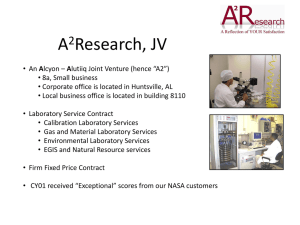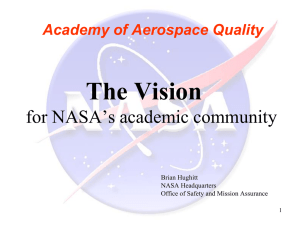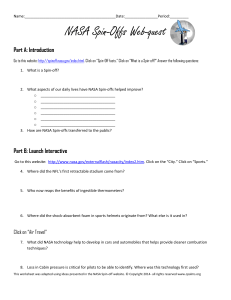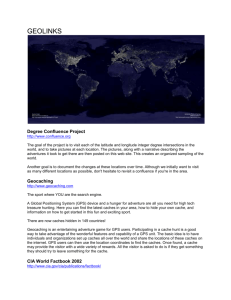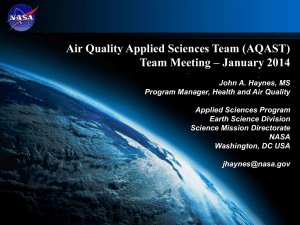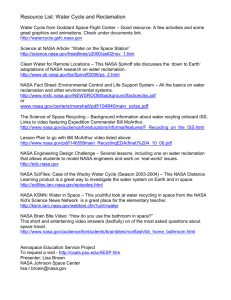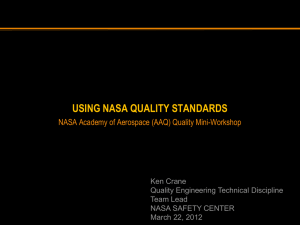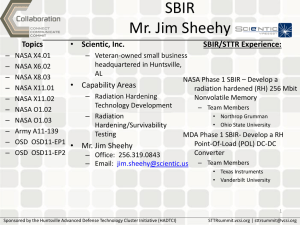A Climate Conversation
advertisement
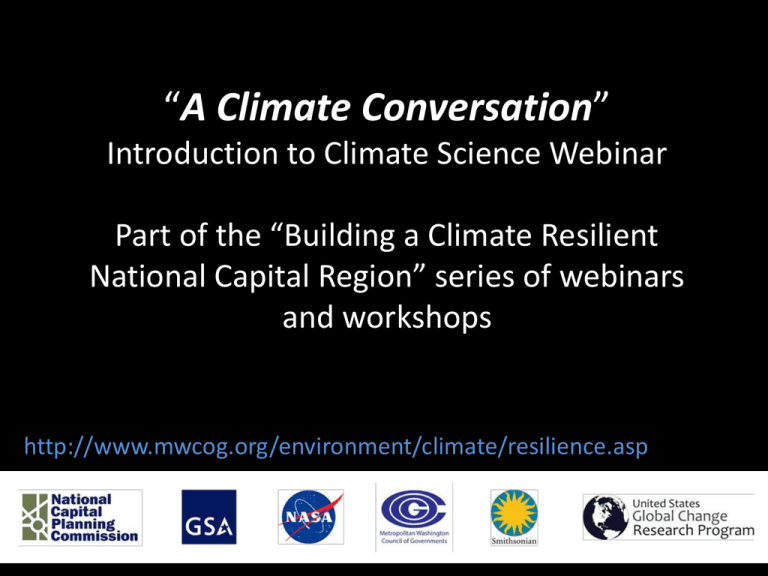
“A Climate Conversation” Introduction to Climate Science Webinar Part of the “Building a Climate Resilient National Capital Region” series of webinars and workshops http://www.mwcog.org/environment/climate/resilience.asp Opening Remarks Lawrence Friedl Director, Applied Sciences Program, Earth Science Division National Aeronautics and Space Administration (NASA) A Climate Conversation: The Decision-Maker Olga Dominguez Associate Administrator for Strategic Infrastructure NASA’s Strategic Sustainability Officer A Climate Conversation: The Scientist Goddard Institute for Space Studies Dan Bader Research Analyst NASA Goddard Institute for Space Studies Trucks Carrying Hurricane Relief Supplies Await Distribution Instructions at NASA’s Stennis Space Center Responding to Climate Risks Mitigate to reduce our impact on natural systems… …and adapt where we nevertheless expect impacts. Question Distinction between weather and climate? Comparing Weather and Climate Weather describes current and nearterm conditions Climate describes weather patterns over a longer term “Weather is what you get; climate is what you expect.” January February Question March April May 2012 What does the climate record tell us? What’s already happened locally? Sea Level has risen over decades, though individual years vary somewhat Temperature has risen too, but the trend varies more year-to-year Trend: +10 in since 1930 Trend: +4.2oF since 1900 A century of local data tells us the climate is changing NOAA 2013 Part of a larger pattern? Trend: +2o F since 1880 NASA GISS Observed local patterns reflect world-wide trends Question What is the basis for climate projections? First principles Scientists have understood this pattern for over a century NASA Gathering better data NASA NASA’s orbital perspective is a critical vantage-point Building on a strong foundation Powerful computer models let us test and refine hypotheses Intergovernmental Panel on Climate Change Consensus-based projections using • • Several models Several future greenhouse gas emission scenarios Updated as the science advances IPCC Models Middle 67% Range of Projections Central range of models is basis for NASA’s projections NASA GISS 2013 Rising precision/resolution over time 1990 1996 2001 2007 New models + better data = more specific projections Question What is projected for Washington DC? What is projected locally? Adjusted for observed rapid ice melting Not adjusted for rapid ice melting Sea level rise is projected to accelerate this century NASA GISS 2013 What is projected locally? NASA GISS 2013 Average temperatures are projected to rise What can a few degrees warmer do? New Average Very Likely Increase: Extremely warm days Average Action Point A small average change can mean a big effect on extremes What can a few degrees warmer do? Days/year below 32oF Days/year Days/year above 90oF Extremes can change much faster than averages. NASA GISS 2013 NCA Regional Climate Scenarios • Information on precipitation are illustrated here for the Northeast Region. Other regions available at: http://scenarios.globalchange.gov/node/1155 Seasonal changes simulated by NARCCAP* indicate an increase in precipitation for winter, spring, and fall, but a decrease for summer National Climate Assessment 2013 *North American Regional Climate Change Assessment Program (NARCCAP) Question What other changes are projected? What other changes are projected? Likely Increase Intense rainfall events More likely than not Increases in drought events Normal Conditions Abnormally Dry Likely Decrease Moderate Drought Severe Drought Snowfall frequency & amount NASA GISS 2013 There’s more to consider than averages Question What types of impacts might these projected changes have on us in terms of workforce, communities, and natural systems? Photo by dbking (Wikimedia Commons) Public Health Impacts Maryland Department of Health and Mental Hygiene The Most Immediate Climate-Related Threats to Public Health in this Region • Air quality • Extreme heat • Floods, droughts, and extreme weather events • Vector borne diseases • Food borne illness • Sea level rise • Contaminated drinking water • Malnourishment & food insecurity Maryland Department of Health and Mental Hygiene The Most At-Risk Populations • • • • • • • • Young children Elderly 65 years old and older Elderly people that live alone Communities already stressed by environmental justice and health factors Socially isolated persons Chronically ill people or people with respiratory diseases Persons living in low-lying land areas Persons that have a low socioeconomic status Maryland Department of Health and Mental Hygiene (2014) Natural Systems Impacts EXAMPLES: • • • • • Inundation of wetlands and low-lying areas. Native species may be forced out of the area. Dead zones in the Chesapeake Bay will likely increase. Establishment of invasive populations of species. Degraded water quality in coastal bays due to increases in winter-spring runoff. • Increased length of the growing season early in century. • Milk and poultry production negatively impacted by heat stress later in the century. • Increased forest vulnerability to drought, insect pests, and forest fires. University of Maryland Center for Environmental Science (2014) For more information… http://www.mwcog.org/environment/climate/resilience.asp NASA For more information… COMING SOON, mobile app with basic location-specific info: NASA QUESTIONS*? *You may also pose questions to NASA climate scientists at any time during the course of this series of webinars and workshops using the link under the Questions & Feedback section on: http://www.mwcog.org/environment/climate/resilience.asp

